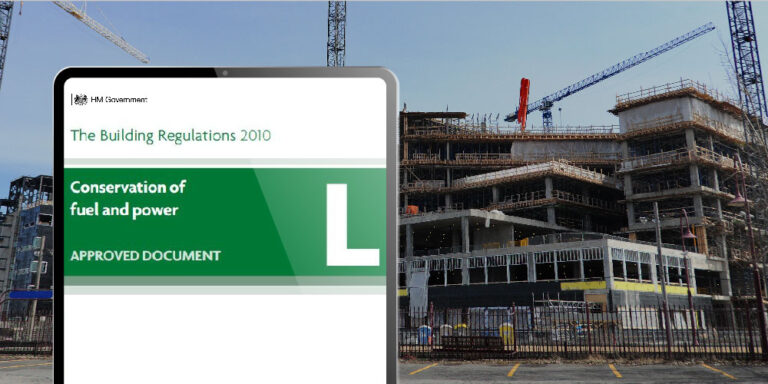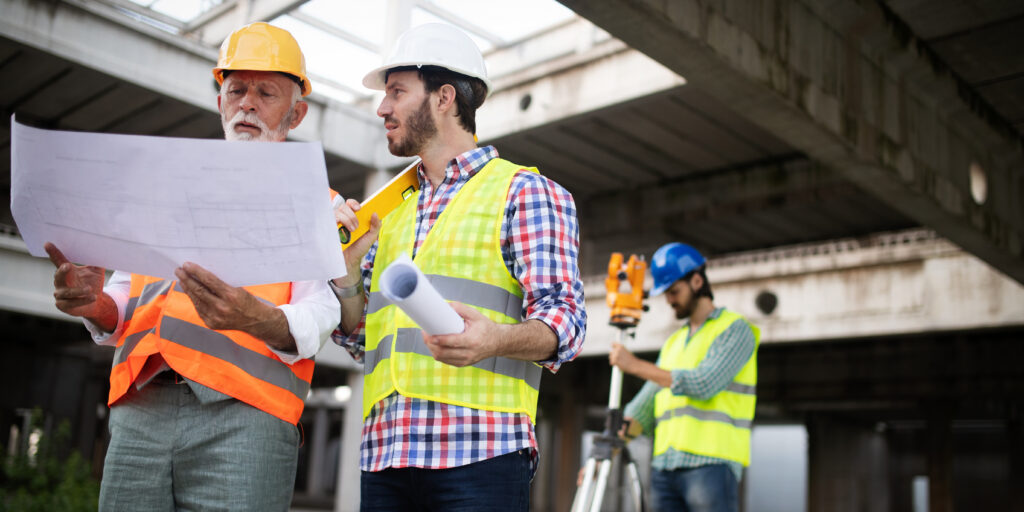— 6 min read
Part L Building Regulations Explained
Last Updated Mar 26, 2025
Last Updated Mar 26, 2025

In 2019, the UK government introduced legally binding targets to reduce greenhouse gas emissions to net zero by 2050. In the much nearer term, as part of the Future Homes Standards, it has set out what it calls “plans to radically improve the energy performance of new homes, with all homes to be highly energy efficient, with low carbon heating and be zero carbon ready by 2025.”
The targets for carbon emission reductions are 75–80% lower than current levels, so the construction industry should expect green construction compliance to be very much part of the day to day for many years to come. The Part L Building Regulations are a key staging post in this journey.
Table of contents
What is Part L?
The Part L Building Regulations, officially known as Approved Document L, address the conservation of fuel and power in new and refurbished dwellings in the UK. The upgraded Part L Building Regulations aim to reduce carbon emissions for new and refurbished buildings by at least 31%. The latest version of Part L was updated in June 2022, and the new requirements have been in force since June 2023.
By setting out and enforcing Building Regulations such as Part L, the government is directing construction’s contribution to a greener and more sustainable future. To enforce the regulations, a new Part L compliance regime now requires contractors to prove they have built dwellings and / non dwellings to the regulation, using materials and methods that meet Part L standards.
Shape the Future of the Built Environment at Procore's Construction Summit
Engage with construction leaders and discover the latest technology and best practices that are driving change across the industry.

How Part L Impacts Construction
Part L Building Regulations have specific requirements that relate to the foundations and external walls of buildings, roofs, openings, airtightness and building services — including boilers. The need for Part L compliance will affect how buildings are commissioned and designed, how materials are selected and priced and how projects are planned. Part L also impacts on governance, on and off-site workflow and skills needs, procurement, manufacturing and sales.
New Construction Projects
The need for Part L compliance means architects must integrate more energy efficient components at the design level, while plumbers, bricklayers, electricians and HVAC technicians will all need to install new, more energy efficient equipment, or build in more energy efficient ways.
The new regulations affect everything from the efficiency of lighting systems to the thickness of walls and the airtightness of windows. Part L1(a) of Schedule 1 of the Building Regulations 2010 deals with limiting heat gains and losses for both new buildings and renovations.
Renovations & Refurbishments
For renovations and refurbishments, work must also consider new energy performance requirements, which could mean installing more efficient heating or improving insulation. Part L sets out how heat gains or losses should be treated, for example, for areas of buildings that are undergoing renovation or change of use.
Builders working on existing buildings must comply with tighter U values — the measurement of how efficiently a wall, floor or roof prevents heat from transmitting from the inside to the outside of the building. The regulations also include rules on the proportion of glazing acceptable in extensions (compared to the floorspace), the thermal separation standards of porches and conservatories, light efficiency standards and new flow temperatures for heating systems.
The regulations also refer to “specific circumstances” that may require additional or alternative measures to achieve compliance with the regulatory requirements, including how Part L interacts with other Building Regulations, namely:
- Part C: Site preparation and resistance to contaminants and moisture
- Part E: Resistance to sound
- Part F: Ventilation
- Part J: Combustion appliances and fuel storage systems
- Part K: Protection from falling, collision and impact
- Part M: Access to and use of buildings
Integration with the Building Safety Act
In parallel with the energy efficiency requirements of Part L, the Building Safety Act introduces key safety regulations for high-risk buildings in the UK.
Brought into effect in April 2022, the Act sets laws for a comprehensive "golden thread" of digital information, ensuring transparency and accountability from the design phase through to construction, and eventually, into operation and maintenance.
The legislation compliments Part L's emphasis on clear documentation by requiring the collection and storage of safety details, leading to enhanced building compliance and safety standards.
The integration of these regulations means that construction projects must now meet stringent energy efficiency standards whilst complying with demanding safety standards.
High-risk buildings must pass through three checkpoints or "gateways" to ensure they meet all regulatory requirements before occupation. This approach protects building users from potential risks and ensures that both energy efficiency and safety are prioritised in the UK.
How to Comply with Part L
For the upgraded Part L Building Regulations, SAP 10 replaces SAP 2012 and contains the methodology for calculating metrics and targets, though how those are achieved is down to the housebuilder. Standard Assessment Procedure (SAP) is a tool that helps ensure homes in the UK are built to be energy-efficient and environmentally friendly.
For SAP assessors to release EPCs (Energy Performance Certificates) and the new BREL Report (Building Regulation England Part L Report), housebuilders need to prove they have completed work to the new standards. BREL reports help building control bodies decide if buildings meet the right standards.
Ultimate responsibility for compliance with the Part L Building Regulations lies with the contractor or the building owners. Architects, planners, tradesmen, designers, managers and investors should all be aware of Part L so that their projects and work do not fail to comply which can result in financial penalties and re-work.
Recording Photographic Evidence
To monitor and enforce the new regime effectively, the government has introduced a compliance process that requires photographic evidence as proof that construction has been carried out to standards and using materials in line with Part L.
The legislation sets out that photographs should be digital and of high quality and resolution to enable qualitative audits of the subject, including close-up photographs where necessary. Assessors’ needs may mean more than one image of each detail is needed. Geolocation should be enabled to confirm the location, date and time of each image. Each image file name should include a plot number and detail reference according to the property detail so that photos are traceable.
Penalties for Non-Compliance with Part L
Local authorities have a remit to prosecute builders for non-compliance to the Building Regulations and courts can fine builders and order costly re-work, or even order the demolition of structures in extreme cases.
Building control officers can refuse to certify properties and instruct builders to take down work. However, the most powerful and common incentive is that, without compliance, properties will not achieve certification and cannot be properly handed over to the owner. An owner accepting a dwelling without full building certification would be taking on risks that are unacceptable to most businesses as non-certified properties would be difficult to market and sell.
Categories:
Tags:
Written by
Anne Hickman
View profileDaniel Kavanagh
15 articles
Daniel Kavanagh is a Senior Strategic Product Consultant at Procore, based in Dublin, Ireland. Daniel is a results-oriented project manager with a passion for building relationships and exceeding client and management expectations, with career experience in project management, systems implementation, technical design and architectural finishes. Daniel has been a member of the construction industry since 2014, and graduated from the Carlow Institute of technology.
View profileReviewed by
Kris Lengieza
Kris Lengieza is the Global Technology Evangelist at Procore Technologies. Kris brings a wealth of experience and passion to the intersection of construction and technology. Previously serving as the VP of Global Partnerships & Alliances, Kris oversaw a diverse ecosystem spanning channel, ISV, public, and association partnerships. His recognition as one of the Top 40 Construction Professionals Under 40 by ENR and BD&C underscores his impact in the industry. Kris’ journey began with 15 years working in the construction field, where he embraced technology as an early adopter and strived to seamlessly integrate data across all construction solutions. As a futurist and construction tech evangelist, Kris now collaborates extensively with industry innovators, tech organizations, and construction companies. Together, they explore transformative technologies that promise to revolutionize our work processes. Kris has played a pivotal role in Procore’s product strategy, delivering industry and technology insights to improve how Procore’s solutions serve the industry.
View profileExplore more helpful resources

Construction Document Software: Essential Tools for Project Success
Construction projects depend on extensive paperwork, including designs, contracts, RFIs, and compliance records. A single misplaced document can trigger delays, disputes, or compliance violations. Despite increasing digital adoption, many teams...

Construction Planning: A Guide to Successful Project Execution
Every successful construction project begins long before the first brick is laid. Indeed, behind each structure – whether a towering skyscraper or complex infrastructure project – lies a carefully crafted...

Leveraging Analytics for Better Financial Forecasting in Construction
Financial forecasting is a difficult task in any industry. In construction, where companies need to manage volatile material costs, labour shortages and variation orders on a daily basis, fluctuations in...

Strategies to Prevent Rework: The Importance of Clear Instructions
In construction, “rework” is the dreaded process of redoing tasks due to mistakes, quality issues, or safety concerns. This unnecessary work drains budgets through wasted materials and labour while causing...